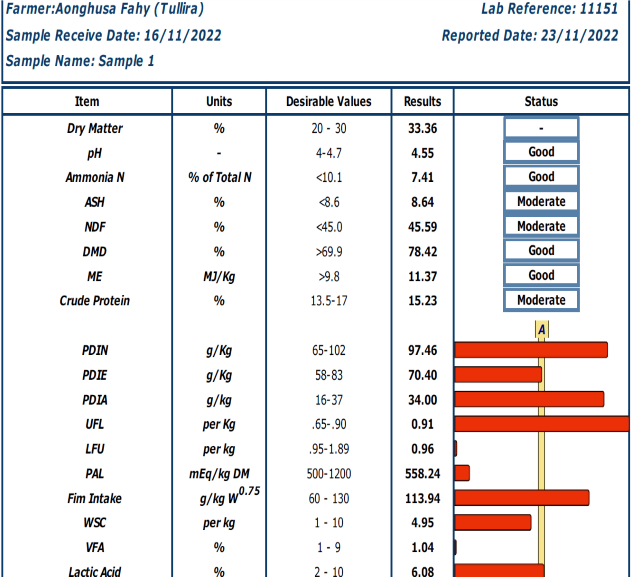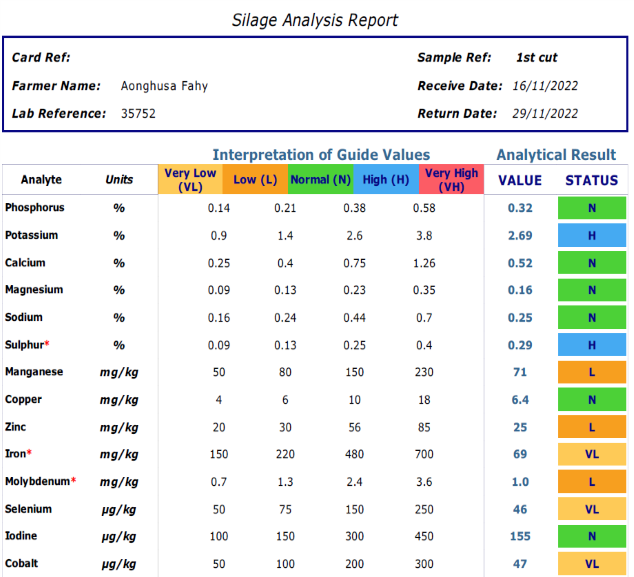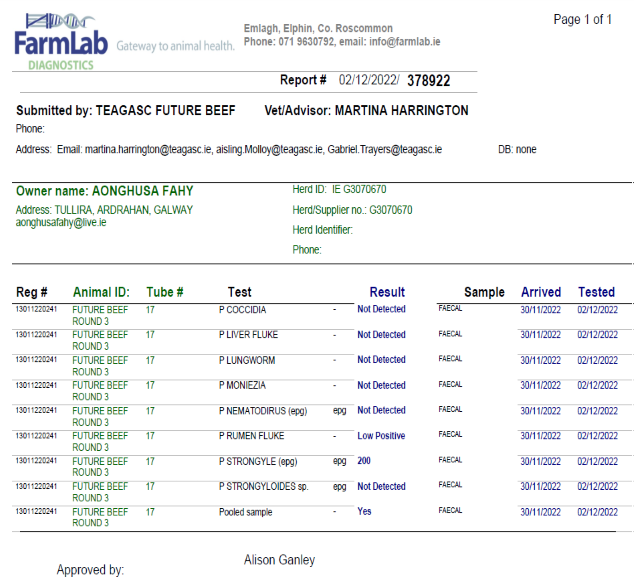Animal Nutrition
The silage results from FBA yielded positive results in terms of quality silage . Bales made from surplus grass had the highest DMD of 78.4% and a CP of 15.2% . These bales are marked and kept for the priority stock such as weanlings.

A mineral analysis was also completed of the silage fed to the cows. The result highlighted normal values for the main macro minerals ie Calcium, Magnesium and Phosphorous. However, there are elevated levels of Sulphur which could lock up copper in the silage. Therefore , the mineral being fed should contain copper in a protected form.

Macro Minerals
Magnesium (Mg): Magnesium plays a crucial role in mobilising calcium from bones and increasing gut absorption, to reduce milk fever. Low levels of magnesium can also cause slow calving. Magnesium is not stored in the body, so it is very important it be fed right up to calving.
After calving Mg supplementation is required especially on lush spring or autumn grass to prevent grass tetany.
Phosphorous (P): Makes up approx. 30% of total minerals in the body. A phosphorous deficiency can severly affect reproduction, causing silent heats, irregular oestrus and low conception rates. Low phosphorous is also associated with pica – i.e. eating stones etc.
Sodium (Na): Aids in nutrient transfer, waste removal, involved in muscle and heart contraction, rumen and blood pH. Deficiency signs are urine licking, reduced male fertility, lower milk production and depraved eating behaviour.
Calcium (Ca): Calcium maintains normal muscle function and a deficiency can cause difficult calving’s and retained placenta. Obviously once a cow is lactating the requirement for calcium increases dramatically, it is a deficiency in calcium that cause milk fever. A cow is unable to physically consume her calcium requirement, she has to mobilise it from her own bones. In order for her to be able to do this post calving, she has to start pre calving. Magnesium aids in this process and this is why minerals high in magnesium are fed pre calving. If calcium is fed pre calving it meets her pre-calving requirement and she won’t have started the process of mobilising calcium from her bones and this will lead to a deficiency after calving, therefore – Do not feed calcium pre calving.
Trace elements
Copper (Cu): Deficiency can lead to small weak calves, scours and decreased milk. In weanlings, it can cause poor growth rates.
Selenium (Se): One of the few elements that can pass through the placenta from the cow to the calf. It is important as a deficiency can cause muscular dystrophy (weakening and wasting of muscle). Some areas are high in Se, so you should test your silage to ensure you do not cause a toxicity. A deficiency can also cause an issue with retained placentas.
Iodine (I): Deficiency can cause small weak calves, dead or hairless calves, or calves that do not want to suck. The animal will have low immunity. It can also lead to poor reproductive performance. It is also not stored in the body and needs to be fed right up to calving.
Cobalt (Co): Involved in the synthesis of B12 by the rumen, deficiencies more often seen in sheep. Can cause a rough coat, poor appetite and anaemia.
Manganese (Mn): A deficiency can affect growth, bone formation and the nervous system leading to poor growth, reproduction and bowing of the joints.
Zinc (Zn): Plays a role in the immune system and repair of damaged tissues. while it is also involved in the synthesis and metabolism of proteins and carbohydrates, teat keratin formation. A deficiency can lead to poor skin, mastitis, slow healing of wounds, bad hoofs and stiff joints. It can also lead to lower conception rates.
Animal Health
Dung samples are taken as part of the programme. The results revealed low incidence of rumen fluke. On discussion with his local vet, this low level did not warrant dosing for fuke and there was no cows showing physical signs of rumen fluke.
However, the weanlings and store cattle have been treated with Albex 10% for the treatment of worms which showed up on the sample result.
All cattle have been clipped and dosed for lice.

Performance
The weanling males were weighed on Nov 28th and they averaged 368kgs . That is a daily gain of 1.24kgs since birth.

The weanling males are penned according to weight with a pen of lighter males getting 1.5kgs of a 13% Crude protein ration while the heavier pen is getting 1kg of meal/day. The heifers average weight was 332kgs on Nov 28th-they are getting 1 kg of ration. All of the males and heifers are getting top quality silage ad-lib.

The cattle have the proper space allowance with all animals having access to the feed barrier at the one time.

